| | | Roman Coastal Reserve | | | Zones | | | Castel Fusano | | | The wildlife |

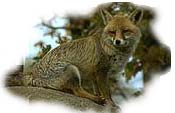 Fox
Fox
|
Great numbers of foxes stealthily cross the scrub in search of wild rabbits or birds, in competiting with beechmartens and weasels. The marten, on the other hand, prefers to hunt between the leafy branches of the trees in search of sleeping woodpigeons or black rats whose nests are often raided by the marten. On the ground, the hedgehog has a quiet life and, along with the mole, is the biggest insectivorous mammal in the Park. Various types of shrewmouse are also to be found, among which the minute "mustiolo etrusco" who is only a couple of centimetres long and is considered Europe's smallest mammal. |
| You might, along any given path, come across a
stocky animal with a caracoling pace and a black and white, striped snout
: it is the proud badger. Similar in size, but of a much more
timid nature, is the porcupine, also present in the Park, who leaves
behind him his black and white aculei, frequently spotted in the Park.
Of the ungulates, the wild-boar is very rarely seen and the roe-deer is almost impossible to catch sight of. Both are, however, certainly present in the Park. |
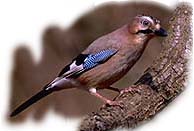 Jay
Jay
|
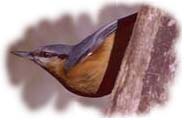 Nuthatch
Nuthatch
|
The numerous birds in the Park are much more easily observed, compared to the fascinating, but shy, mammals. Blackbirds (Turdus merula) accompany any visitors to the Park along their trail and the intelligent and curious Jay (Garrulus glandarius) often approaches an intruder, torn between the desire to observe him and the fear inculcated into him by many centuries of hunting. |
| Very common are the Chaffinch (Fringilla coelebs), the Greenfinch (Chloris chloris), the Goldfinch (Carduelis carduelis) and the Serin (Serinus serinus), as well as the Robin (Erithacus rubecula) and the Blackcap (Sylvia atricapilla). The Great spotted woodpecker (Picoides major) and the Green woodpecker (Picus viridis) are also common, whereas the Lesser spotted woodpecker (Picoides minor) is more of a rarity. The Short-toed treecreeper (Certhia brachydactyla) and the Nuthatch (Sitta europaea), who are not really woodpeckers, are also regulars among the tree trunks. The Nuthatch is particularly sociable and can often be observed very closely, as he hops up and down the tree-trunks in search of the larvae of hylophagous insects. |
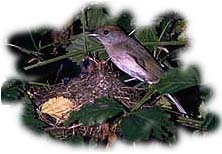 Blackcap at the nest
Blackcap at the nest
|
 Red-backed shrike
Red-backed shrike
|
In the maquis it is usual to hear the contrasting
bursts of song made by the may birds like the Sardinian warbler
(Sylvia melanocephala), the Whitethroat (Sylvia
communis), the Spectacled warbler (Sylvia conspicillata)
and the Subalpine warbler (Sylvia cantillans).It is unnecessary,
if we analyze the names of these birds (which mean dry twig or thorn bush)
to describe their favourite surroundings. In the same kind of environment
the Wren (Troglodytes troglodytes), with her powerful song,
is also a leading character.
In the summer period, other regulars to the Park are the colourful Bee-eater (Merops apiaster), the Hoopoe (Upupa epops), with his striking crest and the Roller (Coracias garrulus) with his iridescent colours. |
| During the migratory periods, the Pied flycatcher (Ficedula hypoleuca) and Spotted flycatcher (Muscicapa striata) hunt for small insects along the paths, whereas the Red-backed shrike (Lanius collurio), the Woodchat shrike (Lanius senator) and the Lesser grey shrike (Lanius minor) hunt, from the highest stems of the plants in the scrub, for coleopteras, small birds and microscopic mammals. Some of these birds then remain to nest. The tit family is, on the contrary, active throughout the whole year, amidst the leafy branches of the trees as they wander, in noisy little bands, through the branches, in search of food. Among the tits one may come across, are the Great tit (Parus major), the Blue tit (Parus caeruleus), the Coal tit (Parus ater) and the Long-tailed tit (Aegithalos caudatus). These are often joined by the Chiffchaffs (Phylloscopus collybita), Wood warblers (Phylloscopus sibilatrix) and the colourful and minute Goldcrests (Regulus regulus) and Firecrests (Regulus ignicapillus). |
 Coal tit
Coal tit
|
| In the darkness of the night, it is possible
to hear a mournful but, at the same time sweet, flute-like sound: it is
made by the Tawny owl (Strix aluco) coming out of his day-time
hiding-place to hunt mice, voles and rats. With him, a small and
pleasant hunter, the Little owl (Athene noctua), sometimes
seen also by day, lets out a sound that is sometimes more like the mewing
of a cat than the hooting of an owl.
Among the reptiles to be found in the Park, are the Whip snake (Coluber viridiflavus), the Aesculapian snake (Elaphe longissima), the Four-lined snake (Elaphe quatuorlineata) and the Grass snake (Natrix natrix). The common Viper (Vipera aspis) is most definitely present and the existence of the Smooth snakes (Coronella austriaca) in the Park is yet to be verified. |
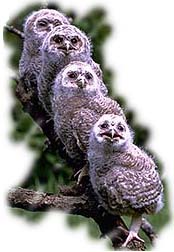 Tawny owl
Tawny owl
|
Extremely rare, but present, is the Hermannís tortoise (Testudo hermanni): operations regarding the problems of this species will, we hope, be put into action in the near future. In the tall grass the Seps (Chalcides chalcides) and the Slow worm (Anguis fragilis) - that seem like a cross between the sorrel and the ofidi - can be found, but it is very difficult to spot either of them, unless accompanied by an expert.
Among the amphibians, very numerous at one time, the only one still definitely present, is the Common toad (Bufo bufo). This scarsity of amphibians is due to the lack of reporductive areas, brought about by the drying-up of the inter-dunal ponds.